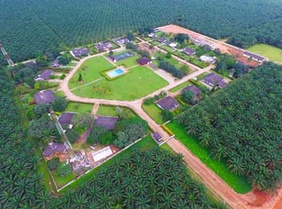
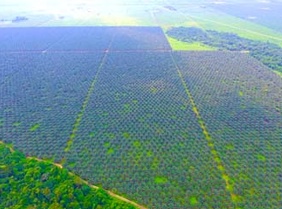

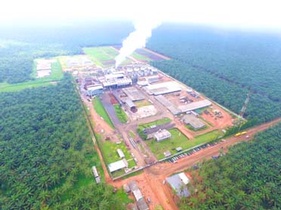

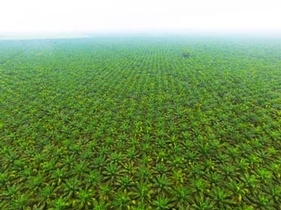
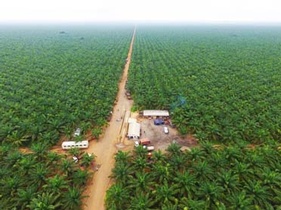
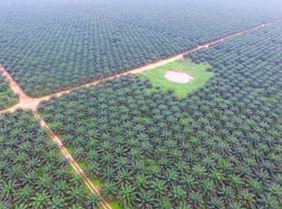
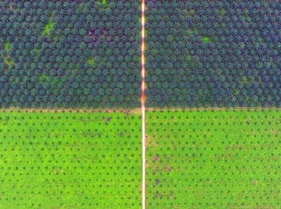
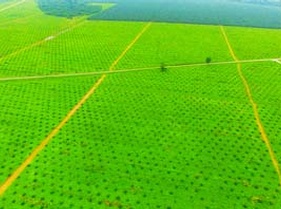
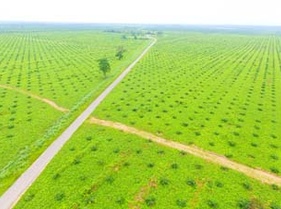
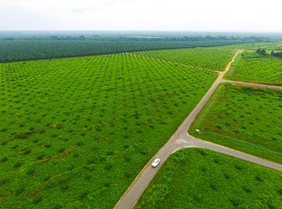
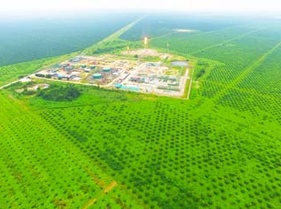
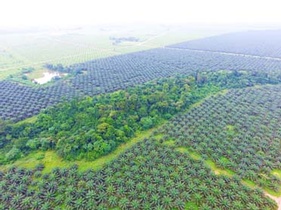
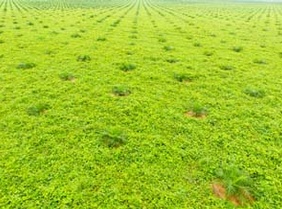
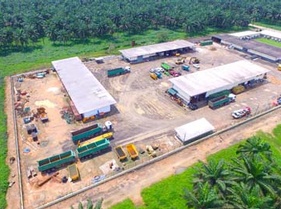
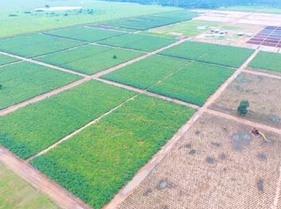
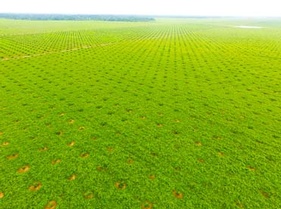
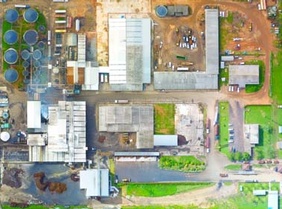

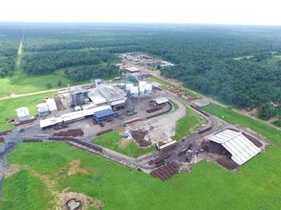
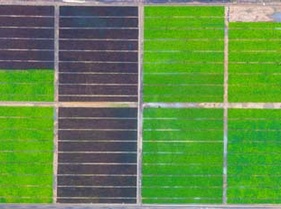
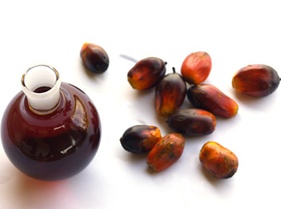
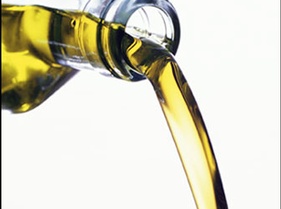
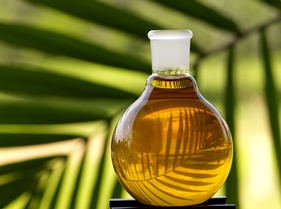
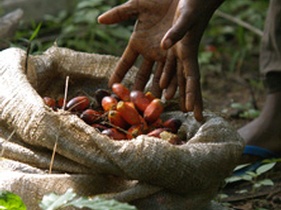
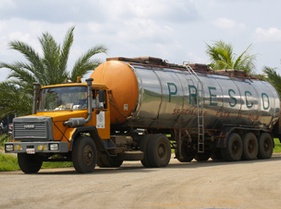
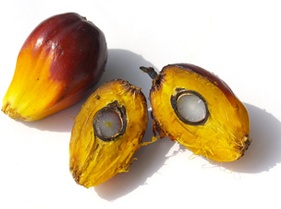
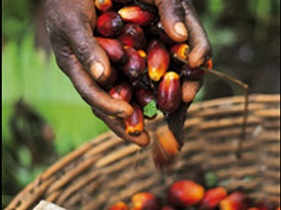

Fresh fruit bunches (FFB) from the plantations are offloaded daily at the factory's offloading bay. This ramp can contain up to 600 tonnes of FFB. Before offloading, the fruit is weighed at the electronic weighbridge at the entrance gate.
|
|
|
Fruits on the ramp are allowed to move gradually onto the FFB conveyors by means of gates. The FFB conveyors take the fruits to fill each sterilizer which has been hydraulically raised to a near vertical position. Once the sterilizer is full, it is lowered to the horizontal position. An automated cycle begins to steam flush air out of the sterilizer for a few minutes. This is followed by a first stage of cooking which ends with the discharge of condensate from the vessel. The second stage automatically follows with more steam coming into the vessel until the maximum pressure of 3 bars is reached. After this stage, the pressure is maintained for cooking for between 35 to 50 minutes based on the fruit's quality. The condensate is discharged again, and the sterilizer is moved to the vertical position for the cooked fruits to be discharged into a chute below. Autoloaders located at the end of the chute gradually release the fruits onto the SFB conveyor below which then moves them to the thresher for threshing.
Thereafter the loose fruits are conveyed to a digester and then to a screw press. At the press, the palm oil is pressed out of the fruits. The oil goes to the de-sanding and decanting tanks, while cake, also containing the palm nuts, is conveyed to the palm kernel recovery station.
The empty fruit bunches (EFB) are recycled in the plantation.
When the oil leaves the screw press it contains water, sand and impurities. During a process of static de-sanding and decanting, most of the impurities in the oil are removed in a centrifugal oil purifier. The last traces of oil in the effluent are recovered in a centrifugal sludge separator.
Now the crude palm oil (CPO) is ready for storage and further processing in the refinery and fractionation plant. There it is processed into refined bleached deodorised oil (RBDO) and palm fatty acid distillate (PFAD). RBDO is then fractionated into palm olein and stearin.
|
|
|
The cake, which was separated in the palm oil mill, goes through a column where air separates fibres and nuts. The fibres are conveyed to the steam boiler as fuel, the nuts go to a nut breaker for cracking. Here the shell is separated from the kernel. Cracked shells and palm kernels are further separated in a clay bath. The shells also go to the steam boiler as fuel. The palm kernels pass through drying silos and into the palm kernel crushing plant.
At the palm kernel crushing plant, presses crush the kernels in two stages. The oil produced is filtered and stored as crude palm kernel oil (CPKO). Here we also have the option to process the oil at the refinery to obtain refined palm kernel oil (RPKO).
The cake remaining after the pressing, is also used in the plantation.
Crude palm oil, after extraction from the bunch, looks at room temperature (e.g. 25°C) like a pasty and strongly red-coloured material. This product is traditionally consumed as such in African countries. However, some consumers and industries require a more finished product.
It is therefore, necessary to find a process to:
The removal of fatty acids, colour and odour can be achieved by the refining (physical or chemical) of the oil.
To obtain a free flowing material, a fractionation process, which allows the separation of the liquid phase from the solid phase is used.
Presco installed the more economic physical refining, as opposed to chemical refining.
The plant consists of three main sections: dry degumming, bleaching and distillation / deodorization. The plant uses a continuous process.
Dry degumming:
In the dry degumming, the crude palm oil is mixed with food grade acid (normally phosphoric acid) in a static mixer followed by a retention vessel. After the retention vessel, the oil and precipitated materials are fed directly to the bleaching section.
Bleaching:
Degummed oil mixed with earth proportioned by an automatic feeding system is heated to processing temperature before entering the vacuum bleacher where it is dried and de-aerated.
During continuous agitation, the bleaching earth absorbs the main particles of colour bodies as well as metal contamination and oxidising materials in the oil. After the bleacher, the oil/earth mixture is passed through filters where the spent earth is removed together with the precipitated materials from degumming. The oil then passes through polishing filters before entering the distillation/deodorisation section via a de-aerator/balance tank.
Distillation/Deodorisation:
The bleached oil is first de-aerated. Next, the oil is heated by deodorised oil (RBDO) leaving the deodoriser in an economiser. After the economiser, the oil is taken through a thermal heat exchanger in order to attain the required process temperature before entering the deodorizer.
In the deodoriser the main body of free fatty acids and other volatile odour and taste substances are removed from the oil. The free fatty acids are reduced to absolute minimum and certain flavour and odorous compounds, which require a longer retention time, are finally removed or inactivated.
The vapours from the deodoriser are gathered in a central manifold leading to the scrubber, where they are passed through a layer of packing cooled by circulating acid oil. Here the fatty acids and other fatty volatiles are condensed and accumulated in the bottom of the fatty acid receiver tank. The level in the fatty acid receiver tank is maintained by constantly discharging a controlled amount of cooled recycled fatty acids.
The oil leaving the deodoriser is cooled to storage temperature and then passed through one of two alternately working polishing filters.
This arrangement was adopted in view of simplicity of operation and maintenance and is better adapted to local conditions.
The product obtained is refined bleached and deodorised oil (RBDO).
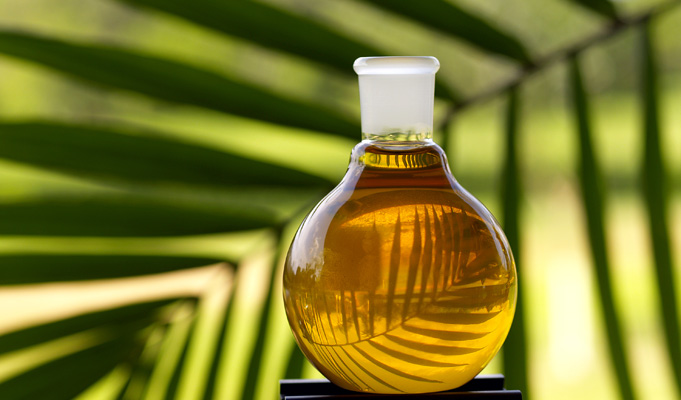
The process of fractionation consists of the separation of the liquid part (olein) from the solid part (stearin). In principle the process is very simple, involving:
Presco adopted the dry fractionation process operating batch-wise, as opposed to centrifugal separation with the aid of detergents or solvent fractionation. With this process oil is kept at a controlled temperature in large tanks with slow stirrers. Crystals form and build into aggregates of several millimetres in diameter. The slurry is pumped through a membrane filter press for separation of the olein and stearin fractions.
The stearin cake obtained from the membrane filter press is melted in the stearin-melting tank below the press, which also acts as a stearin intermediate tank, prior to storage or packaging.





























